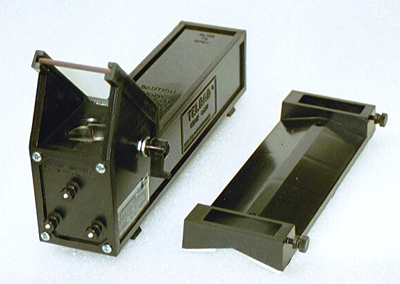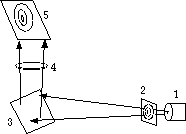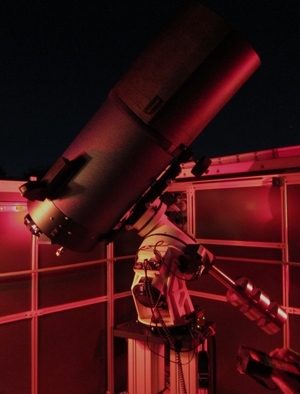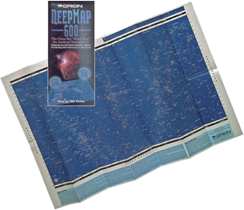Distribution
![]() History
History ![]() Index
Index ![]() News
News ![]()
![]() Pricing
Pricing ![]() Products
Products

TELRAD SIGHT
 Above: Telrad Sight with furnished Quick Release Platform - viewed from right rear. Note three control knobs at rear for adjustment of reticle pattern onto display window and on the right side at the rear is the on-off and brightness adjust dial lever (97,541 bytes) |
The Telrad is a one power (1X) sight that was originally designed for installation onto astronomical telescopes as an aid to locating deep sky wonders at night. While it was not developed as a tool for daytime use some of our customers have adapted the Telrad sight for uses we never anticipated, for example many stage lighting technicians adopted the Telrad to help them point spot lights in the theatre.
The Telrad can be employed as the sole or primary sight of a telescope to help you "star hop" using visible stars to find and center objects that would be invisible to the naked eye or in other small finder telescopes. Or, you may choose to use a Telrad in combination with a second conventional magnifying finder telescope. The Telrad is the innovative, dominant choice of finder sights by the amateur astronomy community, and it is not uncommon to find a Telrad on professional observatory telescopes too! It is a particular favorite among experienced amateurs using deep sky telescopes (particularly our larger "Dobson" style telescopes) where aperture and the ability to find faint deep sky objects are concerns; these include our Astro-Systems and other fine Dobsonians by Obsession and Star Master. The Telrad is often the choice to replace economical finders sights provided on telescopes such as the Orion model XT-10, XT-8, and XT-6. Most of the big telescopes found at any star party get-together will probably have a Telrad on it.
However, because of the Telrad's ungainly appearance and moderate bulk the Telrad is not generally selected for use on smaller, fork mounted telescopes such as the Questar 3-1/2, Maksutov-Cassegrain, or C-5 Series fork mounted Schmidt-Cassegrain, or compact 70mm to 105mm aperture Achromatic and Apochromatic refractor telescopes such as those we offer by TeleVue and Astro-Physics. Customers who do not need the larger field of view of the Telrad, and seek a more compact sight for use with smaller telescopes may wish to consider our Qwikfinder.
History:
The beginnings of Telrad, Inc. originate in the late 1970's when Steve Kufeld of Huntington beach, California came up with the economical sight to help amateur (and professional) astronomers find their way across the night sky. Steve based the Telrad concept on World War II vintage bombsight technology; he simply came up with a new application for it. By the late 1970's Steve had arrived at a prototype. Steve originally made the Telrad body using urethane models from which he cast the body in aluminum. Soon afterwards, an ABS plastic injection mold was made. Since about 1982 this is the basic form of the Telrad which would not be altered to the present day. And since then Telrad has found better ways to make the sight, increased production volumes and improving economy of scale, and so the cost of the sight has remained the same!
Telrad Arrangement:
The Telrad sight is composed of two components: 1) Sight, and 2) Base. The Sight houses the power supply (two "AA" batteries), an on off rotary switch which also can vary the brightness of the display, a red L.E.D. lamp, the Telrad reticle, a mirror to divert the light up towards the 45 degree inclined display window, and a lens to bring the image of the reticle to focus on the window.

Left: Telrad sight reticle pattern projection arrangement (not to scale):
1. Red L.E.D., 2. Telrad reticle, 3. Adjustable tilt flat mirror, 4. focusing lens,
5. display window inclined at 45 degrees shown with simulated projected reticle. (6,999 bytes).
The Telrad optical arrangement is simple, and yet reliable. It provides that the Telrad's distinct pattern, adjustable in brightness, will be projected by a long life red Light Emitting Diode onto the display window. When the window is viewed from the observers vantage point then the pattern will appear to float, apparently suspended in front of the stars or other objects in the background. The Telrad sight is delivered from Company Seven with the reticle pattern focused onto the window. The focus is factory set by the adjusting the spacing between the L.E.D./reticle assembly and the focusing lens. The L.E.D. and reticle assembly are cemented into place within the Telrad housing. One must use care when installing or removing the two "AA" batteries (optional - not included with the Telrad) not to dislodge the L.E.D. reticle assembly.

Left: Telrad Sight Reticle Pattern - display set to near maximum brightness to show up better in photograph (4,298 bytes).
The reticle pattern is scaled so that each one of the three circles appears to cover a set area of sky: 4 degrees for the outer circle, 2 degrees for the middle circle, and 1/2 degree for the circle in the center. And so Star hopping (moving from one star to another) with the sight is very easy:
- the view through the window is "normal" and not reversed left to right, and up side down as is common in many telescope finderscopes,
- one may clearly see the area of sky around the Telrad window,
- the three projected circles help one to learn how to judge angular distances from one object to another.
- the intensity of the reticle can be varied, and with the optional Telrad Pulser blinking circuit kit it can be pulsed on and off repeatedly.
Telrad Installation:
Each Telrad sight is sold furnished with one sight Base. The Base must be installed onto a telescope at a position that will assure:
- the Telrad will not interfere with movement of a telescope - such as in a fork mount.
- the display window will be positioned at a point behind which the observer can easily view the window.
- the sight display axis will be close in line with the optical axis of the telescope, this is to facilitate the alignment of the displayed reticle pattern with the target seen in the telescope.
The Base is best left attached on to a telescope by any one of several ways, this is usually either by double sided adhesive foam provided with the base or by attaching the base with mounting screws through the provided holes in the base. The Base could be strapped onto a telescope, or attached to an accessory plate by those who do not wish to risk marring the expensive finish of a fine telescope. Once the Base is attached to a telescope then the Telrad can be positioned onto and then secured to the Base by the two furnished metal thumb screws. Extra bases are available so that one may move the Telrad sight from one telescope to another.
 The center of the window is about 3-½ inches (89 mm) above the platform (telescope, stage light, etc.) upon which the Telrad is installed, and so seeing into the distance through the sight depends on being able to have the Telrad window remain above obstructions that might be in the way. The optional Telrad Riser is an accessory for the Telrad sight which elevates the Telrad from the Base by either 2 or by 4 inches. The Riser can be installed quickly and with no tools by the user. The Riser is available in either 2 inch or 4 inch heights, these are installed onto the Telrad Quick Release Base and the Telrad sight is installed onto the Riser. The upper platform of the Riser resembles the Telrad Base and accepts the Telrad Sight, while the bottom of the Riser matches the arrangement on the bottom of the Telrad Sight and thus fits perfectly into a Base. These Risers can even be stacked if desired to attain greater elevation.
The center of the window is about 3-½ inches (89 mm) above the platform (telescope, stage light, etc.) upon which the Telrad is installed, and so seeing into the distance through the sight depends on being able to have the Telrad window remain above obstructions that might be in the way. The optional Telrad Riser is an accessory for the Telrad sight which elevates the Telrad from the Base by either 2 or by 4 inches. The Riser can be installed quickly and with no tools by the user. The Riser is available in either 2 inch or 4 inch heights, these are installed onto the Telrad Quick Release Base and the Telrad sight is installed onto the Riser. The upper platform of the Riser resembles the Telrad Base and accepts the Telrad Sight, while the bottom of the Riser matches the arrangement on the bottom of the Telrad Sight and thus fits perfectly into a Base. These Risers can even be stacked if desired to attain greater elevation.
Right: Telrad sight with optional 2 inch high Riser installed (67,567 bytes).
Once the Telrad sight is installed onto the Base then then the reticle pattern must be aligned so that both the telescope and sight are centered onto a distant target. This adjustment my be made during the day or evening. The adjustment is easily managed by the three focus dials located at the rear of the sight housing. These three dials permit the user to tip or tilt the internal flat mirror to shift the position of the pattern on the display window.
Use of the Telrad
To locate an object with the aid of the Telrad, simply move the telescope so that a bright star or other object near the desired object comes into the display window of the Telrad. if the desired object is bright enough to see in the Telrad sight, then simply center the object in the center circle of the Telrad, and then move to the main telescope for detailed look. If the object to be viewed is fainter than what can be seen with the naked eye, then use the Telrad to navigate onto the target by "star hopping".
Some examples of "Star Hopping":
Move the telescope to center the Telrad onto the bright star Betelgeuse (in Orion). Move the telescope to the left (west) about 2-1/2 Reticle diameters. This should put the telescope just about centered onto the Rosette Nebula.
Center the Telrad onto the bright star "Vega". Next move the telescope about two Reticle diameters (about 8 degrees) south east over to the two brightest stars nearest to Vega; these will be the stars "Sulafat" and "Sheliak". Move the telescope to position the stars "Sulafat" and "Sheliak" on the middle ring of the reticle at 9 and at 3 o'clock positions. The "Ring Nebula" should be just about centered in the Reticle.
The more you practice this skill, the easier it becomes to use the Telrad. And a side benefit will be that you improve your own ability to judge angular separations.
 Telrad For 'Go-To' Telescopes?
Telrad For 'Go-To' Telescopes?
We have heard some people suggest that they day of the Finder is over since many modern telescopes incorporate computer controlled mounts that can slew the telescope optical tube from one object to another automatically. But we at Company Seven remind our customers:
- there is nothing fully automatic about an automated telescopes. These, especially transportable models, usually on the user to initiate the computer by pointing the telescope onto two or more known objects in the sky. The Telrad can help the user to quickly find and center target stars.
- do not overlook the utility of having a Telrad atop a telescope that has 'go-to' computer controlled technology. Many people who access these telescopes value the way the Telrad can help them lean the night sky by clearly showing the surrounding stars and other 'landmarks' that border the object of study centered in the telescope. It is not uncommon for Company Seven to install a telescope into an observatory then furnish the telescope with one or more Telrads, so that regardless of the size of the telescope the user can sight up to the night sky through at least one Telrad.
Right: Meade 14" ACF telescope with lens shade atop Astro-Physics 1200GTO mount and Pier-Tech3 adjustable height pier; note one of the two Telrad sights with Dew Shield atop the telescope (47,204 bytes).
Click on image to see enlarged view (94,294 bytes).
So in a sense the telescope and mount are being used as the finder, finding the target so that the surrounding field and its relationship to the object of interest too may be studied!
You may find it helpful to plan your first several observing sessions by using a star chart, with a properly scaled transparent "template" which shows the Telrad Reticle pattern. The template may be placed over the chart to help one navigate across the sky. You may purchase any of a number of commercial star charts which include a Telrad sight pattern overlay, or you may buy an optional overlay, or you make one yourself with the aid of a mechanical drawing compass possibly drawn over a chart printed from a computer planetarium program. The star charts we recommend include:
- Orion DeepMap 600: is a durable and handy folding plasticized Star Chart. It is fully color illustrated and shows the positions of more than six hundred of the finest celestial objects visible from the Northern Hemisphere plotted on a giant 33 x 21 inch full-color star chart by world-renowned celestial cartographer Wil Tirion. The material has been plasticized to repel dew and staining, hence it is very practical for use outdoors at night. Each of the objects are represented by a symbol so that they are easy to differentiate, the chart is easy to read in the dark with a red flashlight. You will preserve your night vision and see more of the night sky when reading this chart with an optional red flashlight. But what really makes this star chart invaluable is its convenience, it folds "accordion style" into a thin pocket-size 4-¾ x 10-½ inches format - just like a road map!
- Tirion "Sky Atlas 2000" Deluxe Edition or Desk Edition. These are our favorites among the more comprehensive Star Atlases. These best selling atlases contains 26 charts showing the whole sky including: 81,312 single, multiple and variable stars of magnitude 8.5 and brighter, and 2,700 deep sky objects (galaxies, nebulae, star clusters, etc.). Each chart includes an acetate overlay for helping to determine accurate positions, and for use with the "Telrad". The Deluxe edition charts are 21 by 16-½ inches printed in color with objects color coded. While the Desk edition charts are 18-1/8 by 13-½ inches printed with black stars against a white background so this is easy to read in the dark with a red flashlight. The laminated versions have each page sealed in clear plastic to protect them from dew or condensation; this also permits writing over the page with dry erase or other non marring markers. These pages are spiral bound and open easily to any page. There is an optional scale available for these atlases, made in the form of a clear plastic triangle with felt feet at a cost of $10 or so.
TELRAD SIGHT SPECIFICATIONS
| SPECIFICATIONS | |
|---|---|
| Window dimension (from observers vantage): | 1-5/8 x 1-3/8 inch (41.3 x 35 mm) |
| Magnification: | 1x (zero power) |
| Housing: | Black finish, ABS plastic construction |
| Retaining thumbscrews (two on the Base): | 6-32, ½ inch long |
| Length overall length: | 8-3/8 inch (21.3 cm) |
| Height overall (on Base): | 5 inch (12.7 cm) |
| Weight with Base and batteries: | 10.9 oz. / 308 g |
| Batteries required: | Two "AA" 1.5 Volt, in series |
| Packing box dimensions: | 10-1/4 x 6-1/2 x 4 inches (26 x 16.5 x 10 cm) |
| Package/Shipping weight: | 14.9 oz. (0.42 kg) |
Contents Copyright 1998-2011 Company Seven All Rights Reserved


